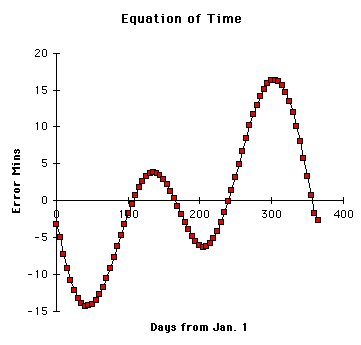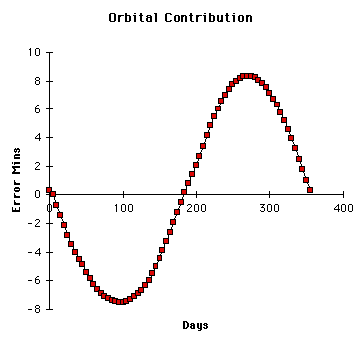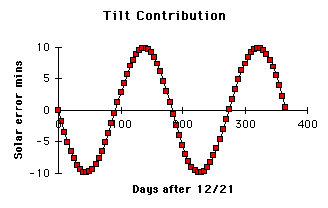UNIVERSITY OF WISCONSIN River Falls
About Us
Equation of Time

The Graph shows the difference between the apparent time indicated by a simple Sundial, only corrected for East west Time Zone effect, and the standard time for that time zone. Negative readings indicate that the Sundial is slow and that time must be added to the Sundial reading to get the standard time. Positive reading on the graph must be subtracted.

There are two contributions to this time difference. One is that the speed of the Earth in its orbit about the Sun varies. The Earth moves fastest when it is closest to the sun, the perihelion, which at present occurs about January 4th. The correction is the difference each day from the average time and this causes the Sundial to be slow in the Spring and fast in the Fall. This correction is not in step with the seasons. It is zero at the aphelion and perihelion of the Earths orbit.

The other effect is more complicated to explain and is caused by the combined effect of the rotation of the earth on its axis and the revolution of the Earth about the Sun. If the earths axis was perpendicular to the plane of its orbit about the Sun, this would just lead to an increase in the length of the day. The earth moves approximately 1 degree about the Sun each day and therefore the Earth must rotate 361 degrees between the Sun crossing the meridian one day and again the next day. The tilt of the Earths axis by approximately 23.5 degrees complicates this and causes a Sundial to be fast and slow twice a year. This correction is in step with the seasons, being zero at the equinoxes and the solstices. The sum of both contributions gives the equation of time.
A more detailed explanation with animations and equations maybe found at http://www.analemma.com/
These corrections are built in to the Swensen Sundial in the form of the analemma shaped hour lines.










